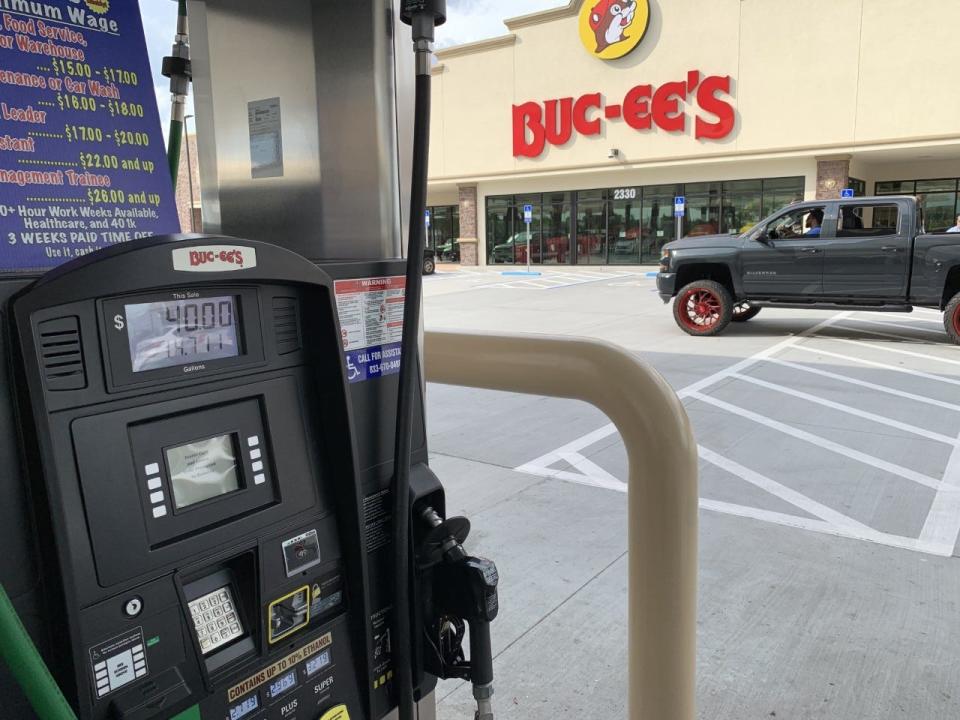Why are Florida's gas prices so low, how long will it continue? Where to find the cheapest gas
Just in time for record amounts of holiday travel, gas prices have plunged across the country and Florida saw one of the steepest declines to the lowest level this year, according to AAA.
The average price of regular unleaded gas in Florida as of Friday, Dec. 15, is $2.886, 16 cents cheaper than the same time the week before and well below the national average of $3.087.
And prices are expected to stay low through the holidays, Mark Jenkins, Tampa-based spokesman for AAA, said.
“Oil and gasoline futures prices plummeted last week, after a weekly fuel report showed strong refinery activity, leading to big gains in gasoline supplies," Jenkins said Monday. "About 35% of Florida gas stations now have fuel below $3 a gallon. Nearly 10% of retailers have prices in the low $2.70s."
The price drops are great timing since AAA projects about 6 million Floridians will be hitting the road during the holiday season an increase from last year.
Where is the cheapest gas in Florida?

As of Friday morning, according to gasbuddy.com listings you can find gas at $2.43 at:
Sunoco, 774 Northlake Blvd & Flagler Blvd, Lake Park
Rocket Fuel, 100 N Federal Hwy & Palmetto Dr, North Palm Beach
Circle K, 250 US-98 N & Duff Rd, Lakeland (cash only)
Generally speaking, the cheapest gas tends to be in the west Panhandle and across Central Florida, according to AAA's gas prices map.
Where is the cheapest, most expensive gas in Florida?
As of Friday, the most expensive markets by average gas prices are Washington ($3.162), Jefferson ($3.154), and Hendry ($3.141).
The least expensive markets are Lake ($2.659), Ocaloosa ($2.74), Pasco ($2.744), and Hernando ($2.745).
Why are gas prices down?
A warmer winter brought by the El Niño weather pattern means less demand for heat and less demand for oil, and an increase in gas production despite lower demand has caused a global drop in gas prices.
OPEC+ announced voluntary production cuts for about 2 million barrels a day and plans to cut oil supply during the first quarter of 2024 to try to keep the cost for oil above $70 a barrel, according to a report from AAA. So far, the oil market has not been impressed, it said.
“Historically, crude oil tends to drop nearly 30 percent from late September into early winter with gasoline prices trailing the play,” said Andrew Gross, AAA spokesperson. “More than half of all US fuel locations have gasoline below $3 per gallon. By the end of the year, the national average may dip that low as well.”
People still want oil — new data from the Energy Information Administration (EIA), gas demand increased slightly from 8.21 to 8.47 million barrels per day in recent weeks — but total domestic gasoline stocks increased significantly by 5.4 million barrels of crude oil to 223.6 million over the same period. More supply, lower prices.
Energy research firm FGE forecasts that OPEC+ will tighten its grip on next year's market and ramp up production in the second half of 2024, Insider reported.
Which states have the lowest gas prices?
Florida is not the cheapest, though. According to AAA, these states have the cheapest average gas prices as of Friday:
Texas ($2.55)
Mississippi ($2.70)
Oklahoma ($2.63)
Missouri ($2.66)
Louisiana ($2.68)
Arkansas ($2.69)
Ohio ($2.74)
Kansas ($2.74)
Alabama ($2.75)
Kentucky ($2.75)
The states with the highest average gas prices, as of Friday, are Hawaii ($4.70), California ($4.63) and Washington ($4.22).
What will holiday traffic be like?
Auto Club AAA is predicting that Floridians will break their own record from 2022 with an estimated 6.6 million of us traveling 50 miles or more during the year-end holiday period from Dec. 23 to Jan. 1. That's nearly 218,000 more Florida travelers packing the roads and airport terminals than last year (a 3.4% increase), not including visitors from out of state.
“AAA has seen steady year-over-year growth in travel demand, culminating with what is expected to be the busiest year-end holiday travel season on record in Florida, and the second-busiest nationwide,” said Debbie Haas, Vice President of Travel for AAA. “Despite various inflationary pressures, Americans are still willing to budget for travel. With a record number of travelers, the roads, airports and cruise lines will be more crowded than normal. So finalize your travel plans now, anticipate longer lines, and give yourself extra time to get to your destination.”
This article originally appeared on The Daytona Beach News-Journal: Florida, U.S. gas prices continue plunge to lowest all year

